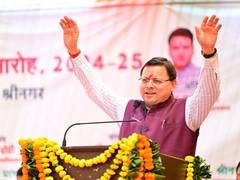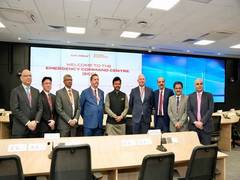Nitish Kumar: Longest-serving Bihar CM, whose survival skills often prevailed over political storms
Patna, Jan 28 (PTI) Janata Dal (United) president Nitish Kumar has distinguished himself as a leader who ruled Bihar for the longest time, without his party having ever won a majority on its own.
Concealed beneath the feat, which testifies to his political acumen and survival instincts, is the fact that the 72-year-old leader could never remain at peace with his allies which also made him change partners frequently.
“The name of Nitish Kumar deserves to enter the Guinness Book of Records for the number of times he has aligned, dumped and realigned with the BJP”, was a tongue-in-cheek remark by Congress MLA from Bhagalpur Ajeet Sharma.
Sharma also cited Kumar’s famous remark “mitti mein mil jaayenge magar BJP ke saath nahin jaaenge” (I shall be consigned to dust rather than going back to the BJP), soon after he had first snapped ties with the saffron party in 2013, following his objections to the national ascendance of Narendra Modi, his then Gujarat counterpart.
No wonder, in a political career spanning four decades, the accusation of “opportunism” and names like ‘Paltu Ram’ has stuck out like a sore thumb, even though there has been no dearth of admirers who remember him for keeping at bay taints of corruption, nepotism and misgovernance, and also never giving in to religious majoritarianism.
Born on March 01, 1951, in Bakhtiyarpur, a nondescript town on the outskirts of Patna, to an Ayurvedic practitioner-cum-freedom fighter father, Kumar is an electrical engineer by training.
During his days at the Bihar Engineering College, now known as NIT, Patna, he became active in student politics and got associated with the “JP movement” which introduced him to many of his future associates, including Lalu Prasad and Sushil Kumar Modi who were then, respectively, president and general secretary of the Patna University Students’ Union.
His first electoral success came in the 1985 assembly elections which the Congress swept though he managed to win the Harnaut seat for Lok Dal.
Five years later, he moved to Delhi as an MP from the now-abolished seat of Barh.
After another half a decade, when the Mandal wave was at its peak and Prasad was reaping its dividends, Kumar sided with George Fernandes to float the Samata Party, which later morphed into the JD(U)) and share power with the BJP at the Centre and, from 2005 onwards, in the state.
His first five years as Chief Minister are recalled with admiration even by critics, marked by vast improvements in the restoration of law and order in a state that made headlines for massacres by rivalling militias and kidnappings for ransom.
A product of the Mandal churn, the Kurmi leader also realised that he did not have the advantage of belonging to a populous caste group and created sub-quotas among OBCs and Dalits who were called “Ati Pichhda” (EBC) and Mahadalits, a decision that was resented by the dominant Yadavs and Dusadhs (supporters of Paswan).
His government hiked the quotas for all the deprived classes recently, a move he had hoped would give a boost to his party’s sagging fortunes and also inspire parties in other states, which had joined him to form the opposition bloc INDIA.
Kumar also gave patronage to “Pasmanda” Muslims which, besides his ability to keep Hindutva vigilantes in check, endeared him to the minority community despite his ties with the BJP.
After his breakup with BJP in 2013, Kumar still survived in power as the JD(U), which was then just a few members short of the majority mark, got outside support from parties like Congress and CPI, besides a disgruntled faction of the RJD. A year later, though, he stepped down owing moral responsibility for the JD(U)’s drubbing in Lok Sabha elections.
In less than a year, he was back as Chief Minister, elbowing out his rebellious prot g Jitan Ram Manjhi, this time armed with ample support from the RJD and the Congress.
The Grand Alliance that came into being with JD(U), Congress and RJD coming together, won the 2015 assembly polls handsomely but came apart in just two years.
Kumar returned to the NDA in 2017, hoping to get some traction after taking a stand against corruption taint on his then deputy Tejashwi Yadav.
Five years later, he again grew disillusioned with the BJP, blaming it for the JD(U)’s debacle in the assembly polls of 2020, when Chirag Paswan fielded many BJP rebels on tickets of his Lok Janshakti Party.
By August 2022, he was back in the Mahagathbandhan or Grand Alliance, which now also included three Left parties.
Although he retained his chair, Kumar indicated that he had his fill and wanted to mentor Yadav, back as his deputy, as his political successor in the state while applying himself with great vigour to bring together all political outfits opposed to the BJP, hoping for a Janata Party-like formation which could, like the post-Emergency polls, pull off a victory against a seemingly invincible regime.
As host of the first meeting of such like-minded parties, held in Patna last year, he was widely regarded as the architect of the opposition front INDIA which, however, baulked at naming him as its convenor, and irked him with suggestions like projecting the elderly Congress president Mallikarjun Kharge as the Prime Ministerial candidate.
Kumar had also been greatly miffed by the delay in seat-sharing arrangements and the inability of the constituents of the united front to sort out differences, as was evident in West Bengal and Punjab.
He had, however, remained confident that his party had better days ahead thanks to recent populist measures of his government, a reason why he was said to have toyed with the idea of dissolving the assembly and going to polls early.






